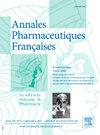大鼠单剂量服用卡莫司汀原料药溶液、柔性脂质体、鼻腔原位凝胶、优化柔性脂质体嵌入鼻腔原位凝胶和上市制剂后的体内药代动力学研究。
IF 1.1
Q4 PHARMACOLOGY & PHARMACY
引用次数: 0
摘要
背景:卡莫司汀用于治疗胶质母细胞瘤(GBM):卡莫司汀用于治疗胶质母细胞瘤(GBM)。胶质母细胞瘤是一种众所周知的危及生命的癌症肿瘤。在所有原发性脑肿瘤中,GBM 占 60.00%,全球发病率为 74,000 例。由于大多数药物都无法穿过血脑屏障(BBB),因此治疗 GBM 仍然非常困难。本研究观察到,柔性脂质体嵌入卡莫司汀鼻腔原位凝胶是通过鼻腔途径治疗 GBM 的最佳脑靶向给药系统:在这项工作中,通过大鼠鼻腔给药,测定了卡莫司汀制剂(即卡莫司汀API(活性药物成分)溶液、柔性脂质体、原位热可逆鼻内凝胶、优化柔性脂质体嵌入原位热可逆鼻内凝胶)的不同药代动力学参数,并与市场上通过静脉途径给药的卡莫司汀静脉注射剂进行了比较。卡莫司汀的测定采用了经过验证的高效液相色谱法(HPLC)。本研究使用了三至四个月大的正常 Wistar 大鼠,雌雄均可,体重 200-250 克:结果表明:与静脉注射卡莫司汀相比,鼻腔内给予经过优化的嵌入鼻腔原位凝胶的柔性脂质体在大脑中的Cmax(∼2倍)、AUC0→t(∼3倍)、AUC0→∞(∼6倍)和Tmax(1小时)数据均有所下降。通过鼻腔途径给药的卡莫司汀的血浆浓度相对低于静脉给药,这表明通过鼻腔途径给药的卡莫司汀的全身暴露量较低:体内药代动力学结果表明,经过优化的柔性脂质体嵌入卡莫司汀原位鼻腔凝胶,可以通过鼻腔给药系统有效地将卡莫司汀输送到 Wistar 大鼠的脑部。本文章由计算机程序翻译,如有差异,请以英文原文为准。
In vivo pharmacokinetic study of carmustine in rats after giving single-dose of carmustine API solution, flexible liposomes, in situ nasal gel, optimized flexible liposomes embedded in situ nasal gel, and marketed formulation
Background
Carmustine is used in the treatment of glioblastoma (GBM). GBM is a well-known life-threatening type of cancerous tumor. GBM covers 60.00% among all primary brain tumors, with an occurrence of 74,000 cases across the globe. Management for GBM is still very difficult because most of the medicines are unable to cross the blood-brain barrier (BBB). The present work observed that flexible liposomes embedded in situ nasal gel of carmustine is the best brain-targeted medicine delivery system for the management of GBM through the nasal route.
Aim
To evaluate in vivo pharmacokinetic parameters of carmustine formulations administered through nasal routes in Wistar rats.
Methods
In this work, different pharmacokinetic parameters were determined for carmustine formulations viz. carmustine API (Active Pharmaceutical Ingredient) solution, flexible liposomes, in situ thermoreversible intranasal gel, optimized flexible liposomes embedded in situ thermoreversible intranasal gel via intranasal administration in rats, and compared with marketed intravenous injection of carmustine administered through intravenous route. Carmustine was estimated with the help of a validated high-performance liquid chromatography (HPLC) approach. Three to four-months-old normal Wistar rats of either sex, having a weight of 200–250 grams were used in this study.
Results
Intranasal administration of optimized flexible liposomes embedded in situ nasal gel showed greater Cmax (∼two-fold), AUC0→t (∼three-fold), AUC0→∞ (∼six-fold), and decreased Tmax (1 h) data in the brain, than commercial intravenous injection of carmustine. The plasma concentration of carmustine administered through nasal route was found to be comparatively lower than intravenous administration, indicating lower systemic exposure to carmustine via the nasal route.
Conclusion
In vivo pharmacokinetics results revealed that the optimized flexible liposomes embedded in situ nasal gel of carmustine can effectively deliver carmustine to brain by nasal drug delivery system in Wistar rats.
Contexte
La carmustine est utilisée dans le traitement du glioblastome (GBM). Le GBM est un type bien connu de tumeur cancéreuse potentiellement mortelle. Le GBM couvre 60,00 % de toutes les tumeurs cérébrales primitives, avec une survenue de 74 000 cas dans le monde. La prise en charge du GBM reste très difficile, car la plupart des médicaments sont incapables de traverser la barrière hémato-encéphalique (BBB). Le présent travail a observé que des liposomes flexibles incorporés dans un gel nasal de carmustine in situ constituent le meilleur système d’administration de médicaments ciblé sur le cerveau pour la gestion du GBM par la voie nasale.
Objectif
Évaluer les paramètres pharmacocinétiques in vivo des formulations de carmustine administrées par voie nasale chez les rats Wistar.
Méthodes
Dans ce travail, différents paramètres pharmacocinétiques ont été déterminés pour les formulations de carmustine, à savoir. solution d’API de carmustine (ingrédient pharmaceutique actif), liposomes flexibles, gel intranasal thermoréversible in situ, liposomes flexibles optimisés intégrés dans un gel intranasal thermoréversible in situ via administration intranasale chez le rat, et comparé à l’injection intraveineuse commercialisée de carmustine administrée par voie intraveineuse. La carmustine a été estimée à l’aide d’une approche validée de chromatographie liquide haute performance (HPLC). Des rats Wistar normaux âgés de trois à quatre mois, des deux sexes, pesant entre 200 et 250 grammes, ont été utilisés dans cette étude.
Résultats
L’administration intranasale de liposomes flexibles optimisés incorporés dans un gel nasal in situ a montré une Cmax plus élevée (∼ deux fois), une ASC0→t (∼ trois fois), une ASC0→∞ (∼ six fois) et une diminution des données sur le Tmax (1 h), dans le cerveau, que l’injection intraveineuse commerciale de carmustine. La concentration plasmatique de carmustine administrée par voie nasale s’est avérée comparativement inférieure à celle de l’administration intraveineuse, ce qui indique une exposition systémique plus faible à la carmustine par voie nasale.
Conclusion
Les résultats pharmacocinétiques in vivo ont révélé que les liposomes flexibles optimisés intégrés au gel nasal de carmustine in situ peuvent délivrer efficacement la carmustine au cerveau par le système d’administration nasale de médicaments chez les rats Wistar.
求助全文
通过发布文献求助,成功后即可免费获取论文全文。
去求助
来源期刊

Annales pharmaceutiques francaises
PHARMACOLOGY & PHARMACY-
CiteScore
1.70
自引率
7.70%
发文量
98
期刊介绍:
This journal proposes a scientific information validated and indexed to be informed about the last research works in all the domains interesting the pharmacy. The original works, general reviews, the focusing, the brief notes, subjected by the best academics and the professionals, propose a synthetic approach of the last progress accomplished in the concerned sectors. The thematic Sessions and the – life of the Academy – resume the communications which, presented in front of the national Academy of pharmacy, are in the heart of the current events.
 求助内容:
求助内容: 应助结果提醒方式:
应助结果提醒方式:


